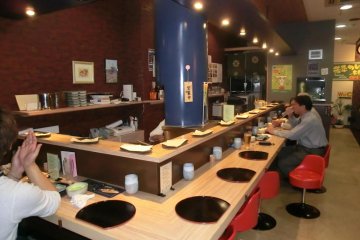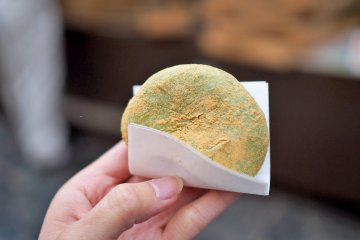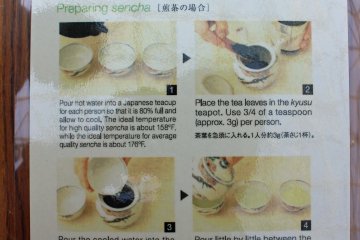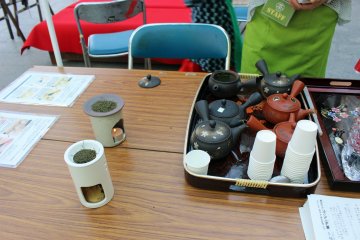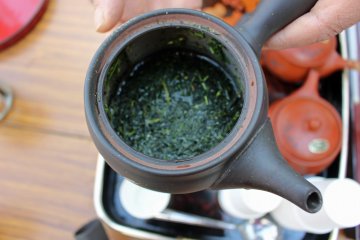Steam rose gently from my cup and the aroma of green tea filled my nose. The first sip sent the slightly bitter, heavy umami flavor of the Nara-grown green tea coursing over my tongue and the tea warmed me from the inside out.
“Do you taste the difference?” asked the farmer who had prepared the tea. “This is how green tea should taste. It must be prepared correctly.”
Background and history
Consumption of green tea in Japan was first recorded in 729 at the Court of Emperor Shomu in present day Nara City. Japanese cultivation of green tea began in present day Uda City in Nara Prefecture when a man named Kobo Daishi brought green tea seeds back from Tang China in 806. At that time what is now known as Nara Prefecture was known as Yamato and the green tea grown there was and still is known as yamato cha (meaning green tea from Yamato).
The balance of sunlight and foggy and moist conditions provided by the mountains and rivers in northern Nara Prefecture provides the perfect growing environment for green tea. Green tea cultivation spread to other areas of Japan from Nara but only tea grown in the original Yamato area has the unique original flavor (green teas from other areas like Shizuoka tend to be sweeter in flavor).
Making the Perfect Pot of Yamato Green Tea
On October 3rd of 2015, the Yamato Tea Growers, in association with the Yamato Highlands Northern Land Area Improvement District, held the first “Appreciation of Yamato Tea” educational event at Kintetsu Nara Station in Nara City.
I lived my first three years in Japan in a green tea town in Shizuoka Prefecture and the farmers in that area taught me a few things about their green tea. I was curious about how Nara's Yamato green tea and its preparation would differ from Shizuoka green tea. After measuring out the appropriate amount of tea for the number of people one is serving (one spoon heaped high with green tea is enough for about 2 to 2.5 cups, use two generously overloaded spoons of loose leaf tea for a standard green tea pot), the farmer poured enough ambient temperature water into the pot to float all the tea in the pot.
“This is the most important step,” the farmer informed me. “The ambient temperature water allows all the leaves to unfurl properly so that the flavor is evenly released.” Room or ambient temperature water also doesn’t cause the tea leaves to release their flavor as quickly as hot water does. Once ambient temperature water is added, the tea leaves need 3 to 10 minutes to unfurl fully.
Giving them up to an hour to open is also acceptable but a minimum of 3-10 minutes is necessary to give the best flavor. Once the leaves had unfurled to the farmer’s satisfaction she poured hot water into the pot, let the tea steep for three minutes and then poured it. Every single serving of tea had the same uniform color despite the order in which it was poured (in Shizuoka tea is poured in stages into each cup to prevent thinning of the tea in later servings), and I detected no difference in flavor between the first and last cups poured.
Getting there from Osaka
Because Kintetsu Nara Station is the event's venue the Kintetsu Line provides the quickest access. Rapid Express and Express service trains depart frequently from Kintetsu Osaka-Namba, Nippon Bashi, Uehonmachi, and Tsuruhashi Stations (Rapid Express Service trains start as far away as Kobe-Sannnomiya). The aforementioned services all terminate at Kintetsu Nara Station. The fare from Osaka-Namba is ¥560, and the Rapid Express Service from there takes about 35 minutes.
Getting there from Kyoto
Kintetsu Express and Limited Express Service trains run from Kyoto Station about twice an hour. The fare is ¥620 for an Express train and takes about 50 minutes. Limited Express trains incur an additional ¥510 reserved seat fee and complete the trip in less than 40 minutes. If there is a long wait until the next direct to Nara train, there is the option of taking a Kashihara Jingumae bound Express or Limited Express train and transferring at Yamato Saidaiji Station. Kashihara Jingumae bound trains share the same platform as trains bound for Nara, Kashihara Jingumae bound trains arrive and depart from track one and Nara bound trains arrive and depart from track 1 and track 2 across the platform, so transferring is quick and easy.



